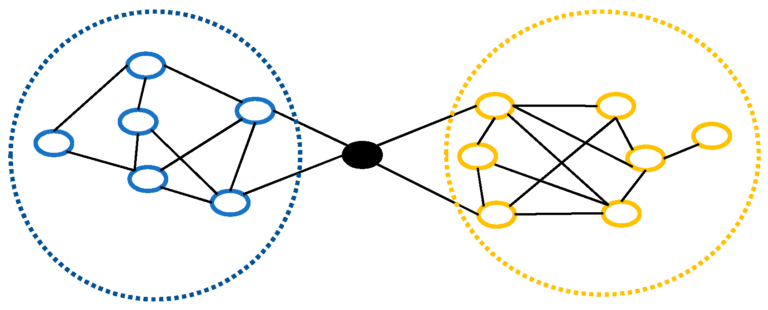Understanding structural holes in a network might sound complicated, but once you break it down step by step, it becomes much simpler. Whether you are studying social networks, business organizations, or other connected systems, identifying structural holes can offer valuable insights and opportunities. This guide explains everything you need to know in a clear and easy manner, helping you identify structural holes effortlessly.
What is a Structural Hole in a Network?
A structural hole in a network refers to a gap between two or more groups or individuals that are not directly connected. In simple terms, it represents missing connections or bridges within a network structure.
Imagine a network of friends. Some people know everyone, while others are isolated and only connected to a few individuals. The gaps between these disconnected groups create structural holes. These holes can be seen as opportunities to bring groups closer or improve overall communication.
For instance, in a business organization, if two departments are not communicating with each other but both interact with one common person, that person acts as a bridge over a structural hole. Recognizing such holes allows you to create better communication channels and more efficient connections.
Why Are Structural Holes Important?
Structural holes play a significant role in various fields, including business, social relationships, and even technology. Identifying these holes can provide numerous benefits, such as:
- Enhanced Communication: Structural holes highlight areas where communication can be improved, helping people connect more effectively.
- Increased Opportunities: By bridging structural holes, individuals or businesses can gain access to untapped opportunities, such as new clients, knowledge, or resources.
- Innovation: Gaps in communication or collaboration often lead to missed opportunities for innovation. By identifying these holes, organizations can foster collaboration and creativity.
- Competitive Advantage: Individuals who bridge structural holes become more influential as they connect with different groups, enabling them to share information and build stronger networks.
In short, structural holes represent opportunities for growth, efficiency, and success. Whether you’re a researcher, a manager, or a student, learning how to identify structural holes in a network can be highly rewarding.
Steps to Find Structural Holes in a Network
Finding structural holes in a network can be approached methodically. Follow these steps to locate and analyze structural holes effectively:

- Understand the Network Structure
Before identifying structural holes, you must first understand the structure of the network you are analyzing. A network is made up of nodes (individuals, groups, or points) and edges (connections between these nodes).
Start by visualizing the network and noting where the connections are strong or weak. By understanding the network’s overall layout, you can more easily spot gaps or isolated clusters.
- Use Network Analysis Tools
To accurately identify structural holes, it’s helpful to use specialized network analysis tools. Tools like Gephi and UCINET allow you to visualize the network, measure connections, and analyze gaps between groups.
These tools provide various metrics, such as betweenness centrality, which can help you locate the nodes that act as bridges over structural holes. They also allow you to map the network in a way that makes it easy to spot missing links or areas lacking connection.
- Look for Non-Connected Clusters
Structural holes often appear as disconnected clusters or groups within a network. By examining the network map, you can identify clusters that are not directly connected to each other.
For example, if you have a network of coworkers and notice that two teams are only connected through one individual, that connection represents a structural hole. The lack of a direct link between the two teams creates an opportunity for improvement.
Tools to Identify Structural Holes Easily
Finding structural holes manually can be time-consuming, especially in large networks. Fortunately, there are tools available that make the process simple and efficient. Here are two widely used tools for network analysis:
Gephi
Gephi is an open-source network analysis tool that allows you to visualize and analyze complex networks. It is especially useful for identifying structural holes because it helps map relationships and highlight gaps in connections.
- Visualization: Gephi provides powerful visual tools to create network graphs, making it easy to identify disconnected clusters.
- Metrics: Gephi offers advanced metrics such as betweenness centrality, degree centrality, and modularity, which are essential for identifying structural holes.
- User-Friendly: Even if you are new to network analysis, Gephi’s interface is relatively easy to navigate and understand.
By using Gephi, you can quickly identify areas where connections are missing and explore opportunities for bridging structural holes.
UCINET
UCINET is another powerful tool for analyzing social networks. It is particularly effective for measuring and identifying structural holes in both small and large networks.
- Detailed Analysis: UCINET provides metrics like structural hole scores, which indicate the presence and size of gaps in a network.
- Integration: It works seamlessly with other software, such as Excel, for importing and exporting network data.
- Advanced Features: UCINET can calculate key indicators like constraint and efficiency, helping you analyze the impact of structural holes within the network.
Using UCINET, you can gain deeper insights into your network and locate areas where new connections can be established to bridge structural holes.
Real-life examples of Structural Holes
Structural holes exist everywhere, from social relationships to business networks. Here are a few real-life examples:
- Social Networks: In a group of friends, two people might not know each other directly but share a mutual friend. The mutual friend acts as a bridge over a structural hole.
- Business Organizations: If two departments in a company rarely collaborate, the gap between them is a structural hole. A manager who connects the two departments can bridge the gap and improve teamwork.
- Online Communities: In forums or social media groups, individuals who connect different communities create bridges over structural holes, enabling the flow of information.
Benefits of Bridging Structural Holes
Bridging structural holes comes with several advantages. Here are some key benefits:

Improved Communication
By connecting isolated groups, communication across the network becomes smoother. Information flows more effectively, leading to better collaboration and understanding.
Access to New Opportunities
Bridging structural holes allows individuals or businesses to discover untapped opportunities. For example, connecting two departments can lead to innovative ideas and projects.
Greater Influence
Individuals who bridge structural holes often gain influence within a network. By acting as connectors, they become essential for communication and collaboration.
Challenges in Finding Structural Holes
While identifying structural holes can be highly beneficial, it comes with certain challenges:
- Complex Networks: In large or highly interconnected networks, it can be difficult to identify specific gaps without the help of advanced tools.
- Data Limitations: Analyzing structural holes requires accurate and complete network data. Missing data can result in incorrect findings.
- Interpretation: Even with the right tools, interpreting structural hole metrics can sometimes be confusing, especially for beginners.
Despite these challenges, using tools like Gephi and UCINET can simplify the process and provide actionable insights.
The Bottom Line
Identifying structural holes in a network is a valuable skill that can enhance communication, collaboration, and growth. By understanding the network structure, using powerful tools like Gephi and UCINET, and analyzing non-connected clusters, you can easily locate structural holes. Bridging these gaps not only improves efficiency but also opens up new opportunities and strengthens relationships.
Whether you’re studying social networks, business organizations, or online communities, understanding structural holes is essential for success. By following the steps outlined in this guide, you can analyze networks effectively and become a bridge over the gaps that hold the key to growth and innovation.


